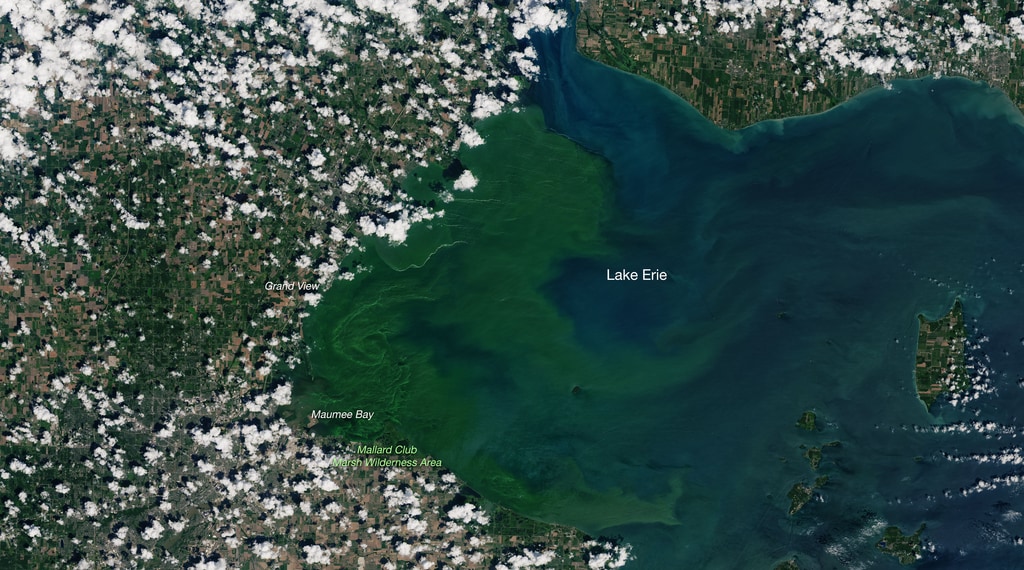Earth
ID: 31051

In July 2019, a severe bloom of blue-green algae began spreading across the western half of Lake Erie. The dominant organism—a Microcystis cyanobacteria—produces the toxin microcystin, which can cause liver damage, numbness, dizziness, and vomiting. On July 29, the National Oceanic Atmospheric Administration (NOAA) reported unsafe toxin concentrations in Lake Erie and have since advised people (and their pets) to stay away from areas where scum is forming on the water surface.
This image shows the bloom on July 30, 2019, as observed by the Operational Land Imager on the Landsat 8 satellite. Green patches show where the bloom was most dense and where toxicity levels were unsafe for recreational activities. Around the time of this image, the bloom covered about 300 square miles of Lake Erie’s surface, according to news reports; by August 13, the algae had spread across 620 square miles.
While blooms in Lake Erie are a regular occurrence in the summer, NOAA researchers forecasted that 2019 could bring some of the most abundant blooms in recent years.
Bloom conditions this year were influenced by calm winds and rainfall. Calm winds in July allowed algal toxins to accumulate at the surface (instead of being dispersed). Strong winds in August have since mixed some surface algae to deeper depths. Heavy rains carry excess nutrients (often fertilizer) from farms into the lake. However, such nutrient runoff may have been less than anticipated this year because heavy spring rains and flooding prevented many farmers from planting crops.
Eerie Blooms in Lake Erie

This image shows the bloom on July 30, 2019, as observed by the Operational Land Imager on the Landsat 8 satellite. Green patches show where the bloom was most dense and where toxicity levels were unsafe for recreational activities. Around the time of this image, the bloom covered about 300 square miles of Lake Erie’s surface, according to news reports; by August 13, the algae had spread across 620 square miles.
While blooms in Lake Erie are a regular occurrence in the summer, NOAA researchers forecasted that 2019 could bring some of the most abundant blooms in recent years.
Bloom conditions this year were influenced by calm winds and rainfall. Calm winds in July allowed algal toxins to accumulate at the surface (instead of being dispersed). Strong winds in August have since mixed some surface algae to deeper depths. Heavy rains carry excess nutrients (often fertilizer) from farms into the lake. However, such nutrient runoff may have been less than anticipated this year because heavy spring rains and flooding prevented many farmers from planting crops.
For More Information
Credits
Amy Moran (Global Science and Technology, Inc.): Lead Technical Support
Kasha Patel (NASA/GSFC): Lead Writer
Joshua Stevens (SSAI): Lead Data Visualizer
Kasha Patel (NASA/GSFC): Lead Writer
Joshua Stevens (SSAI): Lead Data Visualizer
Please give credit for this item to:
NASA's Goddard Space Flight Center
NASA's Goddard Space Flight Center
Short URL to share this page:
https://svs.gsfc.nasa.gov/31051
Keywords:
SVS >> Algae Blooms
SVS >> Landsat
SVS >> Hyperwall
NASA Science >> Earth
GCMD >> Earth Science >> Biological Classification >> Bacteria/archaea >> Cyanobacteria (blue-green Algae)
GCMD keywords can be found on the Internet with the following citation: Olsen, L.M., G. Major, K. Shein, J. Scialdone, S. Ritz, T. Stevens, M. Morahan, A. Aleman, R. Vogel, S. Leicester, H. Weir, M. Meaux, S. Grebas, C.Solomon, M. Holland, T. Northcutt, R. A. Restrepo, R. Bilodeau, 2013. NASA/Global Change Master Directory (GCMD) Earth Science Keywords. Version 8.0.0.0.0
https://svs.gsfc.nasa.gov/31051
Keywords:
SVS >> Algae Blooms
SVS >> Landsat
SVS >> Hyperwall
NASA Science >> Earth
GCMD >> Earth Science >> Biological Classification >> Bacteria/archaea >> Cyanobacteria (blue-green Algae)
GCMD keywords can be found on the Internet with the following citation: Olsen, L.M., G. Major, K. Shein, J. Scialdone, S. Ritz, T. Stevens, M. Morahan, A. Aleman, R. Vogel, S. Leicester, H. Weir, M. Meaux, S. Grebas, C.Solomon, M. Holland, T. Northcutt, R. A. Restrepo, R. Bilodeau, 2013. NASA/Global Change Master Directory (GCMD) Earth Science Keywords. Version 8.0.0.0.0











